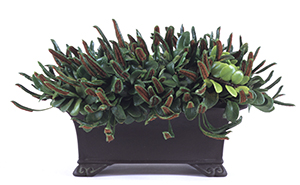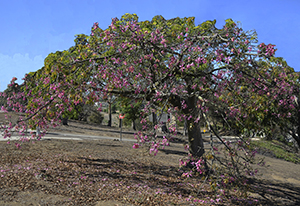Know Your Tree
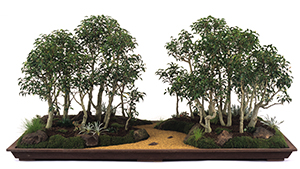
‘Little Lucy’Ficus Benjamina
by Lew Buller
Ficus benjamina comes from India and Malaysia and requires warm temperatures and regular water.
It can be grown outside year round in areas that do not experience frost, grown indoors as a house plant, or a combination of the two–outside in summer, indoors when the temperature is cooler.
Know Your Tree
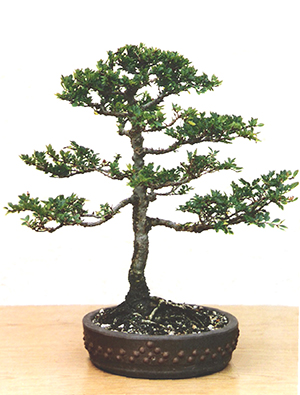
A Yatsubusa Elm
by Lew Buller
As usual before writing an article, I checked the Internet for information. The few Yatsubusa Elm trees shown were both expensive and misshapen. Misshapen because it takes a long time to learn how to grow this tree, and expensive because the growth is so slow.
I wouldn’t suggest starting this tree from a cutting unless you are under 50 years of age or have a successor in mind. Wikipedia had almost nothing in January 2015 so I added some information from the material that follows.
Know Your Tree
Accessory Plants
by Lew Buller
If you plan to display your tree with an accessory at a club show, ask if there are any club rules about display. Some clubs have very strict rules. Small accessories are easily taken by curious visitors, so use accessories large enough they will not be hidden easily in a purse or pocket.
Know Your Tree
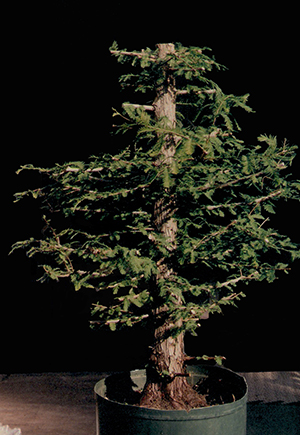
Taxodium Distichum ‘Bald Cypress’
by Lew Buller
My bald cypress is one of my favorite trees. If there were a fire and I could take only two trees, the bald cypress would be one of them. When I got it in 1995 from a friend, Brian, who had grown it in the ground for seven years in San Diego, I decided to learn as much as I could about their cultivation.
San Diego, California is a natural desert area if that tells you something about the adaptability of the bald cypress.
Know Your Tree
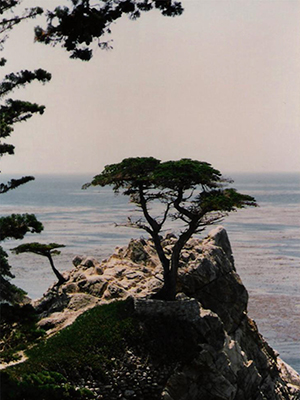
Golden Monterey Cypress
Cupressus Microcarpa Aurea
by Lew Buller
Not all of my attempts to create bonsai turn out to be Cinderella stories. I bought two cypresses for $3.98 each from the discontinued section of a nursery.
Having decided to become a generalist, I sold the second one at a reasonable price at a bonsai club sale and a friend bought it. Shortly thereafter, he informed me that he had resold it to someone who wanted it at twice the price he had paid for it. Didn’t even give me a commission on the sale.
The other I kept and worked on for several years. It taught me a great deal and I got a great satisfaction out of seeing it develop. The last thing it taught me was that I needed to learn something about grafting. I would have put foliage closer to the trunk; it doesn’t back-sprout.
Read more: Cupressus Microcarpa Aurea ‘Golden Monterey Cypress’
Know Your Tree
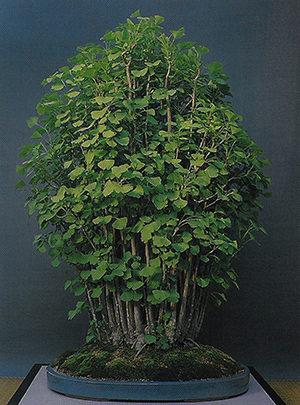
Gingko Biloba
by Lew Buller
Steve, the arborist I worked with, and I used to spend our spare time haunting nurseries, looking for plants that could be turned into bonsai. At one nursery going out of business, we found a couple of trees that had potential. Both had been ruthlessly broken down as they were considered not saleable and the owner did not want to move them. He gave them to us.
This Gingko was only about half the height of the tree it became with some tender loving care. The other was an Elaeagnus, that eventually became such a nice tree that it was featured on the cover of Number 4, Volume 38, Winter 2004 Journal of the American Bonsai Society. The Gingko appears on page 109 and the Elaeagnus on page 107 of Sunset Press’s January 2003 book, Sunset Bonsai. Not bad for two throw-away trees.
Also called the Maidenhair Tree (or Duck’s Foot tree), when young it is a comparatively smooth-barked, sparingly branched tree. As it ages, sometimes reaching 120 feet in height, the bark may become rougher. The leaves are 2-4 inches wide and nearly as long; in form, veining, and appearance they resemble the leaves of the maidenhair fern. The leaf also looks like a duck’s foot. John Rojas, Jr. on page 156 in his book Chula Vista’s Trees, refers to a Gingko in Sendai, Japan which is 97 feet tall, 27 feet in circumference, and estimated to be 1,200 years old. He also says “The oldest specimen in America is in Woodlands Cemetery, Philadelphia, brought from England in 1784. The name Gingko is a misrendering of the Japanese gin, meaning silver, and kyo, meaning apricot.”
Know Your Tree
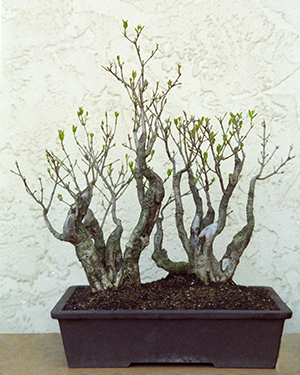
Ligustrum Japonicum ‘Texanum’
by Lew Buller
The Internet has a number of articles on the use of privets in bonsai. Some are developed in Chinese style as befits a Chinese privet; most deal with oversized old hedgerow stumps, and many attempt to sell you a privet. Probably the most useful is Zach Smith’s “Chinese Privet as Bonsai” in the ABS Journal, Summer 1990, Volume 24, Number 2, pp. 8-10.
The closest thing to a hedgerow privet I found came from an old nursery in the Pacific Beach area. The owner had dug the trees many years ago, stuck them in the back of the nursery, and because neither landscapers nor bonsai artists had found them of any interest, the trees were not transplanted but rather left in the original window box. I paid $35 for them, took them home, and proceeded to find out what kinds of roots they had.
They survived the surgery and went into separate pots. They would need more surgery, a great deal of carving to reduce the old trunks to a size proportional to the branches and leaves. The one thing I knew was that any carving should be done in stages and it should stop way above the soil level. With no leaves to support roots if the cuts were made clear to the ground, the roots would die and the process of trunk rotting would begin. I had neither the skill not the tools to do the carving, so after a while I did the prudent thing and planted them in the ground.
Know Your Tree
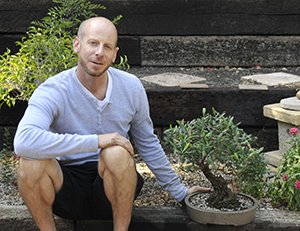
Olea Europaea ‘Little Ollie’
by Lew Buller
Eitan the Apprentice with olive he just transplanted June 8, 2014.
When I first started learning about bonsai, I used to wander around the many San Diego nurseries expecting to find a hidden gem and take it home at a bargain price. It didn’t happen. Instead, I began to look through the sale items that had crooked trunks, roots exposed from years of heavy watering, one-sided trees–misfits, in other words. I acquired a taste for such trees and that accounts for some of the designs I have to this day. They were cheap; I didn’t intend to kill them, but if I did, I had not lost a fortune.
Before I started writing this, I checked the Internet to see if someone else had written about a ‘Little Ollie” bonsai. Didn’t find any articles, but did find a lot of advertisements from garden centers supplying this olive. None of them advertised plants in early stages of development.
Know Your Tree
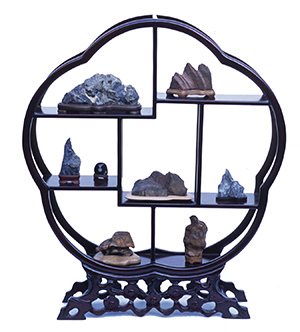
Stones
by Lew Buller
If you are surprised to see an article on stones in this series, stop and think of the full title of the BCI Magazine. It is BCI Bonsai and Stone Appreciation. Stones, usually presented on base, are often used as accessories to bonsai in shows. In some cases, the stones are an exhibit in their own right, either individually if they are large or in a group if they are small.
The stand at left is 17 3/8” tall from the very bottom of the stand to the top. Three of the small stones are owned by my arborist friend, Steve.
The Floss Silk Tree
Chorisia Speciosa
by Lew Buller
In San Diego, the Chorisia speciosa (floss silk tree) starts blooming in early fall and continues to carry flowers until late December, offering color at an otherwise drab time of year. The tree is used as a street tree in San Diego, and its flowers are one of the main reasons.
Its hardiness, its unusual green bark and thorny trunk, its rapid growth–3 to 5 feet a year for the first few years; 30 to 60 feet at maturity–and its tolerance for dry, hot weather make this Brazilian native a good choice for landscapes here.
Know Your Tree
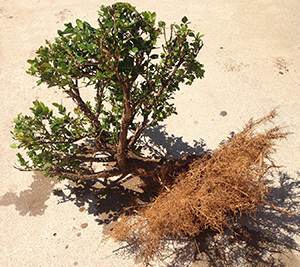
Yamadori from the Yard
Text by Lew Buller
Photos by Eitan Hagler and Lew Buller
Quite a number of bonsai artists have posted articles on collecting trees from the wild. Those of us who like our creature comforts prefer getting yamadori from our yard, or the neighbors’ yards, or somewhere close that does not require any more supplies than a shovel, a pot, and perhaps some soil and replacement plants.
So it is with Buxus microphylla japonica, Japanese boxwood, used in San Diego for years.

